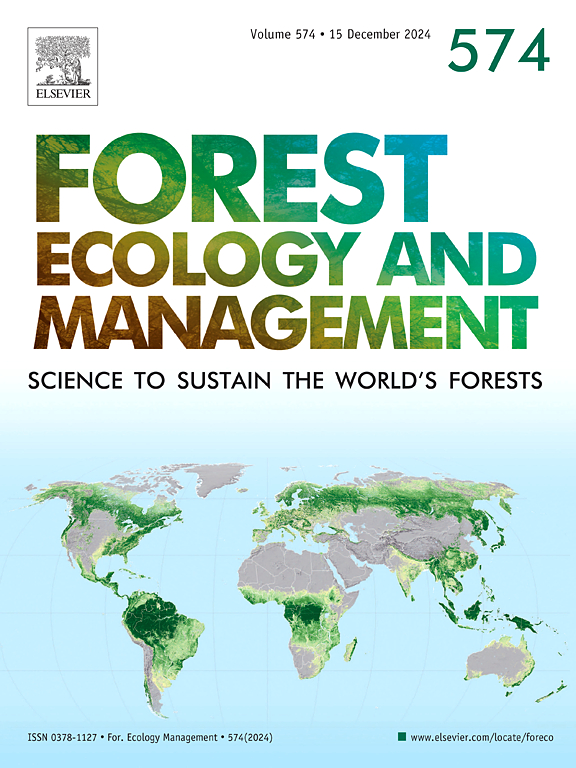IF 3.7
2区 农林科学
Q1 FORESTRY
引用次数: 0
摘要
亚热带森林是重要的碳汇地区,影响该地区树木径向生长的因素复杂多样。以往的研究主要关注单一因素对径向生长的影响,但多种因素如何影响树木径向生长及其内部关系尚未明确。在本研究中,我们通过构建 16 个树环年表,并结合四个潜在变量(气候、土壤、空间因子和冠层叶片功能性状),利用偏最小二乘路径模型(PLS-PM)建立了针叶树和阔叶树的径向生长模型。我们发现,树冠功能特征直接驱动亚热带森林中树木的径向生长。然而,气候对径向生长的直接影响部分被气候通过树冠对径向生长的间接影响所抵消。此外,在所有模型中,空间因素和土壤通过不同途径间接影响径向生长,但影响程度较弱。总之,我们的工作为基于冠层监测评估亚热带森林的生长动态和碳汇潜力提供了证据。本文章由计算机程序翻译,如有差异,请以英文原文为准。
Canopy functional traits directly drive tree radial growth in subtropical forests
Subtropical forests are important carbon sink areas, and the factors affecting tree radial growth in this area are complex and diverse. Previous studies primarily focused on the effects of single factors on radial growth, but how multiple factors affect tree radial growth and their internal relations have not been clarified. In this study, by constructing 16 tree-ring chronologies and combining four potential variables (climate, soil, spatial factors, and canopy leaf functional traits), we established radial growth models of coniferous and broad-leaved trees using a partial least squares path model (PLS-PM). We found that canopy functional traits directly drive tree radial growth in subtropical forests. However, the direct effect of climate on radial growth is partially offset by the indirect effect of climate on radial growth through canopy. Moreover, in all models, spatial factors and soil indirectly affect radial growth through different paths, although the influence is weak. Together, our work provides evidence for assessing the growth dynamics and carbon sink potential of subtropical forests based on canopy monitoring.
求助全文
通过发布文献求助,成功后即可免费获取论文全文。
去求助
来源期刊

Forest Ecology and Management
农林科学-林学
CiteScore
7.50
自引率
10.80%
发文量
665
审稿时长
39 days
期刊介绍:
Forest Ecology and Management publishes scientific articles linking forest ecology with forest management, focusing on the application of biological, ecological and social knowledge to the management and conservation of plantations and natural forests. The scope of the journal includes all forest ecosystems of the world.
A peer-review process ensures the quality and international interest of the manuscripts accepted for publication. The journal encourages communication between scientists in disparate fields who share a common interest in ecology and forest management, bridging the gap between research workers and forest managers.
We encourage submission of papers that will have the strongest interest and value to the Journal''s international readership. Some key features of papers with strong interest include:
1. Clear connections between the ecology and management of forests;
2. Novel ideas or approaches to important challenges in forest ecology and management;
3. Studies that address a population of interest beyond the scale of single research sites, Three key points in the design of forest experiments, Forest Ecology and Management 255 (2008) 2022-2023);
4. Review Articles on timely, important topics. Authors are welcome to contact one of the editors to discuss the suitability of a potential review manuscript.
The Journal encourages proposals for special issues examining important areas of forest ecology and management. Potential guest editors should contact any of the Editors to begin discussions about topics, potential papers, and other details.
 求助内容:
求助内容: 应助结果提醒方式:
应助结果提醒方式:


